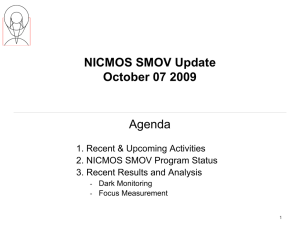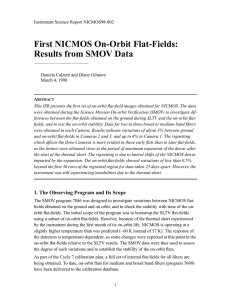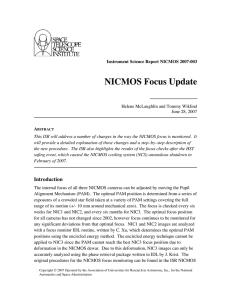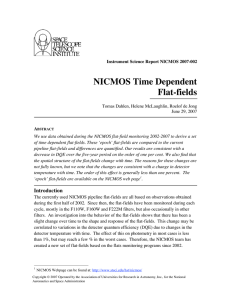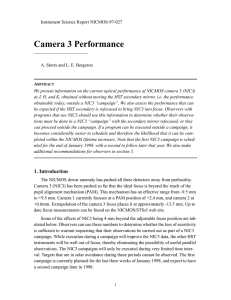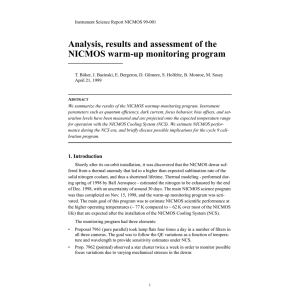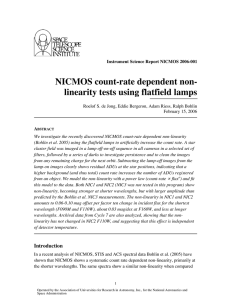SM3B Science Flats
advertisement
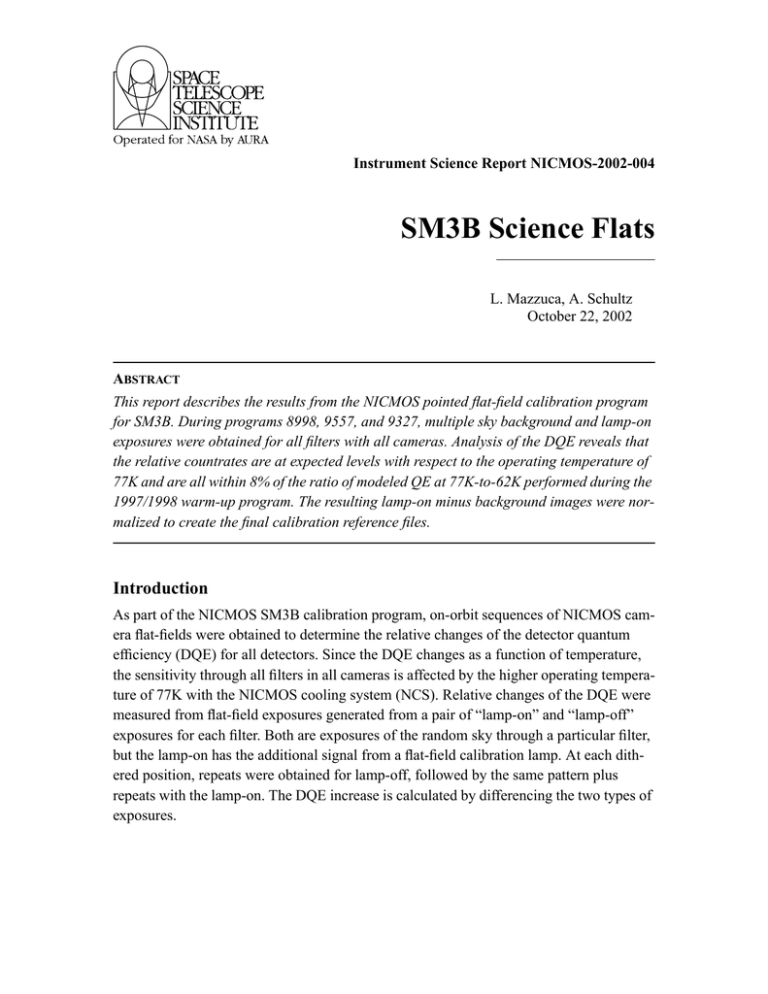
Instrument Science Report NICMOS-2002-004 SM3B Science Flats L. Mazzuca, A. Schultz October 22, 2002 ABSTRACT This report describes the results from the NICMOS pointed flat-field calibration program for SM3B. During programs 8998, 9557, and 9327, multiple sky background and lamp-on exposures were obtained for all filters with all cameras. Analysis of the DQE reveals that the relative countrates are at expected levels with respect to the operating temperature of 77K and are all within 8% of the ratio of modeled QE at 77K-to-62K performed during the 1997/1998 warm-up program. The resulting lamp-on minus background images were normalized to create the final calibration reference files. Introduction As part of the NICMOS SM3B calibration program, on-orbit sequences of NICMOS camera flat-fields were obtained to determine the relative changes of the detector quantum efficiency (DQE) for all detectors. Since the DQE changes as a function of temperature, the sensitivity through all filters in all cameras is affected by the higher operating temperature of 77K with the NICMOS cooling system (NCS). Relative changes of the DQE were measured from flat-field exposures generated from a pair of “lamp-on” and “lamp-off” exposures for each filter. Both are exposures of the random sky through a particular filter, but the lamp-on has the additional signal from a flat-field calibration lamp. At each dithered position, repeats were obtained for lamp-off, followed by the same pattern plus repeats with the lamp-on. The DQE increase is calculated by differencing the two types of exposures. Instrument Science Report NICMOS-2002-004 Observations During SM3B, NICMOS calibration program 8985 obtained flat-field images of several filters for each of the three cameras. Program 9557 continued flat-field observations for Camera 3 narrow band filter and grism flat-field observations. Later in the cycle, program 9327 obtained narrow band filter flat-fields for Camera 1. All three calibration programs executed as Continuous Viewing Zone (CVZ) programs on May 18th, June 10th,, and August 29th 2002, respectively. Multiple exposures were taken of background and lampon observations, equally. Exposure times for all observations using a given filter were identical. Background observations were obtained first followed by lamp-on observations. The data were obtained using MULTIACCUM mode. Table 1 presents the specifics for the observations. Table 1. Filters used for Calibration Programs 8985, 9557, & 9327 SAMP-SEQ # Exposures (lamp off + on) nic1 f090m STEP32 10 95.96 8985 nic1 f095n STEP128 10 895.92 9327 nic1 f097n STEP128 10 767.93 9327 nic1 f108n STEP128 10 895.92 9327 nic1 f110m STEP32 10 95.96 8985 nic1 f110w STEP8 20 3.196 8985 nic1 f113n STEP128 10 767.93 9327 nic1 140w STEP8 20 23.96 8985 nic1 f145m STEP32 10 95.9 8985 nic1 f160w STEP16 10 63.95 8985 nic1 f164n STEP128 10 767.93 9327 nic1 f165m STEP64 10 127.96 9327 nic1 f166n STEP128 10 767.93 9327 nic1 f170m STEP64 10 127.96 8985 nic1 f187n STEP128 10 895.92 9327 nic1 f190n STEP128 10 767.93 9327 nic1 pol0S STEP32 10 95.96 8985 nic1 pol120S STEP32 10 95.96 8985 nic1 pol240S STEP32 10 95.96 8985 Camera/Filter 2 Exposure Time (s) Program Instrument Science Report NICMOS-2002-004 SAMP-SEQ # Exposures (lamp off + on) nic2 f110w STEP1 20 7.97 8985 nic2 f165m STEP8 20 3.196 8985 nic2 f171m STEP32 10 95.96 8985 nic2 f180m STEP32 10 95.96 8985 nic2 f187n STEP128 10 383.95 8985 nic2 f187w STEP8 20 39.95 8985 nic2 f190n STEP128 10 383.95 8985 nic2 f204m STEP64 10 127.96 8985 nic2 f205w STEP8 20 23.96 8985 nic2 f207m STEP32 10 95.96 8985 nic2 f222m STEP32 10 95.96 8985 nic2 f237m STEP32 10 95.96 8985 nic2 pol0L STEP32 10 95.96 8985 nic2 pol120L STEP32 10 95.96 8985 nic2 pol240L STEP32 10 95.96 8985 nic3 f108n STEP16 18 31.96 9557 nic3 f110w STEP1 10 3.989 9327 nic3 f113n STEP16 16 31.96 9557 nic3 f150w STEP1 10 3.989 8985 nic3 f160w STEP1 10 22.951 8985 nic3 f164n STEP16 16 31.96 9557 nic3 f166n STEP16 16 31.96 9557 nic3 f175w STEP1 10 3.989 8985 nic3 f187n STEP16 18 31.96 9557 nic3 f190n STEP16 16 31.96 9557 nic3 f196n STEP16 16 31.96 9557 nic3 f200n STEP16 16 31.96 9557 nic3 f212n STEP16 16 31.96 9557 nic3 f215n STEP16 16 31.96 9557 nic3 f222m STEP2 10 13.957 9327 Camera/Filter 3 Exposure Time (s) Program Instrument Science Report NICMOS-2002-004 SAMP-SEQ # Exposures (lamp off + on) STEP2 10 11.963 8985 nic3 g096 MCAMRR 14 2.72 9557 nic3 g141 MCAMRR 14 1.81 9557 nic3 g206 MCAMRR 14 1.81 9557 Camera/Filter nic3 f240m Exposure Time (s) Program Detector Quantum Efficiency (DQE) The 8985/ 9557/9327 flat-field observations were used to determine the DQE for the current operating temperature of 77K. One representative background and lamp-on exposure per filter was used for analysis. The second column of Table 2 presents the median countrates computed from differencing the two exposures. The countrates were calculated using the integration times and median fluxes in the area [1:256,56:256] for all cameras. The DQE scaling factor data points from the warm-up phase (at 77K) and post-NCS era are seen in the 3rd and 4th columns, respectively, of Table 2. There is overall good agreement between the DQE warm-up and the SM3B NCS values. The DQE was projected to be approximately 40% higher at 77K (using data from the 1997/1998 warm-up program). On average the actual DQE increased by 53% for NIC1, 32% for NIC2, and 32% for NIC3, with an increased sensitivity toward the blue end of the wavelength spectrum, as expected. The last column of Table 2 indicates the difference from projected values to be within ± 8 %. Table 2. Median Countrates and Relative DQE Values. Camera/Filter Median Countrate (cts/s) Modeled Ratio DQE Actual Ratio DQE % Difference nic1 f090m 248.88 1.7 1.79 5 nic1 f095n 12.80 1.7 n/a* n/a* nic1 f097n 14.70 1.7 1.61 (5) nic1 f108n 15.62 1.7 1.66 4 nic1 f110m 354.50 1.7 1.81 6 nic1 f110w 980.50 1.6 1.66 4 nic1 f113n 16.85 1.6 1.59 (1) 4 Instrument Science Report NICMOS-2002-004 Camera/Filter Median Countrate (cts/s) Modeled Ratio DQE Actual Ratio DQE % Difference nic1 140w 1059.49 1.5 1.54 3 nic1 f145m 244.87 1.5 1.53 2 nic1 f160w 442.16 1.5 1.50 0 nic1 f165m 210.20 1.5 1.47 (2) nic1 f170m 203.32 1.5 1.44 (4) nic1 f187n 14.56 1.4 1.34 (4) nic1 f190n 13.52 1.4 1.3 (7) nic1 pol0S 377.64 1.7 1.84 8 nic1 pol120S 380.30 1.7 1.86 9 nic1 pol240S 376.53 1.7 1.85 9 nic2 f110w 3508.11 1.5 1.49 (1) nic2 f165m 715.61 1.4 1.35 (3) nic2 f171m 266.79 1.4 1.39 (1) nic2 f180m 231.35 1.4 1.36 (3) nic2 f187n 53.67 1.3 1.38 6 nic2 f187w 598.19 1.3 1.32 2 nic2 f190n 50.57 1.3 1.33 3 nic2 f204m 240.40 1.3 1.32 2 nic2 f205w 1356.47 1.3 1.29 (1) nic2 f207m 305.66 1.3 1.30 0 nic2 f222m 250.24 1.3 1.27 (2) nic2 f237m 231.05 1.2 1.15 (4) nic2 pol0L 250.45 1.3 1.33 3 nic2 pol120L 249.04 1.3 1.35 4 nic2 pol240L 249.34 1.3 1.20 (8) nic3 f108n 302.31 1.6 1.60 0 nic3 f110w 19254.90 1.6 1.63 2 nic3 f113n 342.93 1.6 1.59 (1) nic3 f150w 18336.6 1.4 1.42 1 nic3 f160w 8065.60 1.4 1.40 0 5 Instrument Science Report NICMOS-2002-004 Camera/Filter Median Countrate (cts/s) Modeled Ratio DQE Actual Ratio DQE % Difference nic3 f164n 331.38 1.4 1.30 (7) nic3 f166n 311.91 1.4 1.31 (7) nic3 f175w 19279.0 1.3 1.40 7 nic3 f187n 251.51 1.3 1.21 (7) nic3 f190n 255.05 1.3 1.22 (6) nic3 f196n 252.05 1.3 1.20 (8) nic3 f200n 249.14 1.3 1.20 (8) nic3 f212n 214.57 1.2 1.17 (2) nic3 f215n 194.26 1.2 1.18 (2) nic3 f222m 1292.74 1.2 1.19 (1) nic3 f240m 1489.34 1.1 1.09 (1) nic3 g096 1.772.70 n/a 1.76 n/a nic3 g141 13630.50 n/a 1.47 n/a 11464.20 n/a 1.30 n/a nic3 g206 *no pre-SM3B archive exists to compare DQE ratios During the NICMOS flat monitoring program 7691 in Cycle 7, flats were also taken multiple times a day in a number of filters in all cameras in order to follow the quantum efficiency (QE) variations as a function of temperature and wavelength. By determining the exact DQE as the detectors heated up, the DQE for all filters could be modeled for the NICMOS Cooling System (NCS) operating temperature (see NICMOS ISR 99-001). Expectations were that low sensitivity pixels would experience a significant increase in DQE, especially at shorter wavelengths. A comparison between Figures 1 and 2 further indicates a nominal difference between projected and actual values. Figure 1 shows the ratio of the modeled DQE at 77 K to the DQE at 62 K, as a function of wavelength. The data points are DQE scaling factors, which were calculated during the warm-up monitoring for a subset of wavelengths (filters). The continuous lines are linear fits extrapolated from the average measured in the three cameras. For all regions, the DQE increased roughly linearly between 62K and 77K. 6 Instrument Science Report NICMOS-2002-004 Figure 1: Ratio of modeled DQE at 77K to DQE at 62K. During SM3B, the scaling factors were computed directly from the countrates of the lampon minus the background images compared to the countrates computed from archive files before warm-up. Figure 2 gives the new data points and linear slopes based on the scaling factors computed. Figure 2: Scaling factors of DQE based on a comparison of SM3B flat-field calibration proposals to the 1997/1998 pre-warmup values (at 62K) 7 Instrument Science Report NICMOS-2002-004 The small differences in scaling factors between the modeled warm-up data and the postNCS data are graphically represented in Figure 3 (see also the last column of Table 2). Figure 3: Difference between the SM3B observed DQE scaling factors and prediction of the factors based on warm-up data analysis. The resulting wavelength dependence of the expected DQE for NICMOS operations at 77K is shown in Figure 4. Here, we have scaled the pre-launch DQE curve, which was derived from ground testing of the detectors, to reflect the changes measured at the wavelengths used in the SM3B and calibration programs. There is a clear increase in sensitivity for all cameras. Figure 4: Actual NICMOS DQE as a function of wavelength for operations at 77K, compared to pre-launch measurements at 63K 8 Instrument Science Report NICMOS-2002-004 Creating the Flat-fields Calibration reference flat-fields were created similar to the method used during Cycle 7 and 7N (see ISR 98-003). The STSDAS tasks clanica, mscombine, msstat, and msarith were used to perform calibration and image processing. See the ISR for details of the calibration switch settings used. The sets of background and lamp-on images were combined separately and then subtracted. The resulting lamp-on minus background image was normalized and inverted to create the final “superflat”. These flats are now considered to be the current calibration reference files. They are available from the HST Archive to all NICMOS observers. Figure 5 gives a representative view of a superflat for each camera. Figure 5: An example of a generated “superflat” flat-field for each camera: F110M (NIC1), F187W (NIC2), F113N (NIC3) from left to right. Note: these flats were generated with a blank bad pixel mask. Once a mask is created, it will be applied to the images. The images are inverted to better display the grot; therefore, the dark regions have higher relative QE while those that are bright have lower relative QE. Grot Upon visual inspection of the flat-fields after the servicing mission, it became obvious that more grot accrued on the detectors. Figure 6 gives an example of an individual flat-field exposure before and after SM3B for each of the three cameras. The most notable addition is a group of 27 pixels located at the bottom right quadrant on the NIC1 detector. A more detailed analysis of grot will be performed at a future date. 9 Instrument Science Report NICMOS-2002-004 Figure 6: Representative individual flats taken for filters F110M (NIC1), F187W (NIC2) and F113N (NIC3) before and after installation of the NCS. The histograms show the “flattening” of the arrays at the higher temperature. Again, the dark regions have higher relative QE while those that are bright have lower relative QE. Conclusions and Recommendations Overall, there are no obvious changes to the morphology of the flat-field images when compared to the pre-NCS images. As expected, detector sensitivity has increased for all cameras. One flat-field per filter from proposals 8985, 9557, and 9327 has been created and delivered to OPUS. NICMOS observations being processed through the OPUS pipeline will be calibrated using these flat-fields. 10
